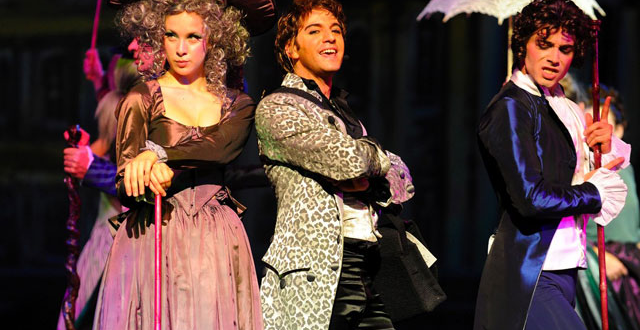The idea of recreating classical music always makes me excited. No wonder how Mozart L’Opera Rock caught my eye at first glance, especially with two such opposing possibilities of music. The musical proves to be worthwhile to watch, even engendering my obsession for a month with its powerful music, fantastic casting, beautiful stage design, and innovative choreography.
The significance and influence of Austrian composer Wolfgang Amadeus Mozart on music cannot be overstated. His rather short life as an extremely talented and prolific composer leaves a bright mark on history, passes the test of time, and continues to amaze and allure us. This amazement and interest provoked countless people to bring their own imagination to present Mozart’s turbulent yet legendary life. Biographies, movies, musicals, and other genres of art thus emerged to achieve this goal, though some of them over-dramatized his life to make these recreations more entertaining.
Among all the imaginations people put on Mozart’s life, his relationship with Salieri, an Italian composer who, though not as talented as Mozart, was diligent and extraordinary, is the central affair people dramatize and fantasize. This inaccuracy started with the poetic drama Mozart and Salieri composed by Alexander Pushkin and was further ingrained into people’s minds through the well-known film Amadeus. Likewise, Mozart L’Opera Rock has its climax in this relationship. Rumor has it that Salieri’s destructive envy of Mozart led him to sabotage Mozart’s career at every opportunity. Whispers spoke of Salieri’s secret plots, underhanded maneuvers, and even suggestions that he might have poisoned the young prodigy to eliminate his rival. But the truth is, they can fight like kindergarten kids when they disagree, while Mozart spent his whole life
insisting that Salieri was his friend and musical confidant and that Salieri had too many times publicly professed his love for Mozart’s music. In a way, ever since the two first met, they have been each other’s haunting shadows, friends, rivals and confidants.
Using dramatic and powerful music and stage design, Salieri’s internal struggle – the extreme admiration of Mozart’s music as the sound of God and the overwhelming jealousy that leads to profound self-denial – is vividly presented to the audience. Le Bien Qui Fait Mal begins with a melancholic and almost reverent tone as Salieri acknowledges the brilliance and divine talent of Mozart. The music grows increasingly intense, swelling with a sense of longing, despair, and agony. At the end, as the soprano voice in The Magic Flute echoes at the back, the music elevates to another realm, giving goosebumps to everyone listening. Other music sung by Salieri in the musical, such as L’Assasymphonie, are all powerful and electrifying, especially with the performance of Florent Mothe (original cast). They lay bare his pernicious obsession with Mozart. After all, who’s not obsessed with that free and pure soul of music?
Played by Michelangelo Loconte in the original cast, Mozart meets the audience as he leaps to the stage, singing, and dramatically bows. His infectious energy immediately captivates, showing this perfect blend of childlike wonder and pure genius. Like a free elf, Mozart jumps around the stage, eyes sparkling with mischief and creativity, drawing the audience into his world of musical enchantment. Loconte’s portrayal captures the essence of Mozart’s spirit – untamed, brilliant, and utterly captivating. As he launches into his first song, his voice soars with effortless grace, enabling the audience to witness the birth of musical brilliance right before their eyes – we are able to feel a genius who lived and breathed music.
However, even though the tone of the whole musical is quite uplifted (at least compared to Mozart! Das Musical) and romantic, the unfulfilled potential of a genius ultimately leaves one feeling depressed. The lyrics of Tatoue-moi are unrestrained and carefree, sung to Paris by young Mozart, who had a heart full of sincerity and love, even though this city hurt him deeply. Then comes Vivre à en crever (Live to the fullest), where Mozart mocks death and time. The melody and the voice seem to have a magic that turns death into nothing but a test and reminder of Mozart’s intellectual and spiritual freedom. In that moment when the spotlight shines down, Mozart truly becomes an angel.
One interesting coincidence that I feel compelled to share: Mozart’s actor Mikelangelo Loconte’s birthday coincides with Mozart’s death on December 5th; besides, while Mozart died at 35 years old with the echo of Requiem, Mikelangelo got this role that would change his whole life at 35.
Not only are the two main characters carefully designed, but the portrayal of other figures important to Mozart’s life is also well-rounded and complex. I specifically want to mention the female characters, who are surprisingly lively and impressive, demonstrating a thoughtful approach to character development through costume design and musical composition.
Nannerl, Mozart’s sister, wears a striking white dress in Act I adorned with a large black butterfly on the back. This design cleverly references the black and white keys of a piano, symbolizing Nannerl’s own musical talent and her connection to the world of music that she shares with her brother. The visual metaphor not only enhances her character but also subtly reminds the audience of her often overlooked abilities as a musician in her own right.
The sisters Aloysia and Constanze Weber are similarly well-developed characters, each with their own distinct personality and musical presence. The first appearance of Aloysia in Bim Bam Boum was truly eye-opening – Aloysia looks like the goddess of the Moon. Her costume, a shimmering silver gown that catches and reflects the light, enhances this lunar imagery, making her seem to glow from within. As Aloysia begins to sing, her voice soars with a crystalline clarity that perfectly matches her celestial appearance. However, the lyrics she delivers, coupled with her poised movements, reveal a woman who is strategically minded about how to use her beauty and talent to her advantage, but at the same time, chapped within, fully aware of her earthly desires and vulnerabilities. Six Pieds Sous Terre is another one of my favorites as the smoky voice of Claire Perot as Constanze Weber, Mozart’s wife and Aloysia Weber’s sister, is just so attractive. Most importantly, as a fight song, Six Pieds Sous Terre provides an endearing platform for Aloysia and Constanze to show them as real, lively young women navigating complex emotions and societal expectations. Through these thoughtful character portrayals, the musical succeeds in bringing depth and nuance to the women in Mozart’s story, elevating them beyond mere supporting roles and giving them their own moments to shine on stage.
Unlike conventional musicals, Mozart l’Opéra Rock boasts a distinctive and powerful stylistic approach. Rather than meticulously portraying the historical Mozart with excessive caution, it presents a nearly revolutionary reimagining of the composer, rooted in contemporary concepts, interpretations, and emotional resonance. This reimagining stems from a profound empathy with Mozart’s works.
The musical taps into Mozart’s position at the tail end of the classical music era, drawing on his compositional tendencies that blended courtly styles with popular appeal, emphasized wit, and highlighted the stories of common people and even nonconformists. Through this lens, the show distills the inherent rebelliousness and free spirit at the core of Mozart’s soul, discarding the traditional narrative that often paints him solely as a figure of elegance, divine favor, and glory. If Mozart lived right now, I guess he would be a rock star.
S’il faut mourir
Sur nos stèles, je veux graver
Que nos rires
Ont berné
La mort et le temps
If we have to die
On our graves, I want to carve
That our laughs
Have fooled
Death and time – Vivre A En Crever
 Tempus Magazine By Students, For Students
Tempus Magazine By Students, For Students 



